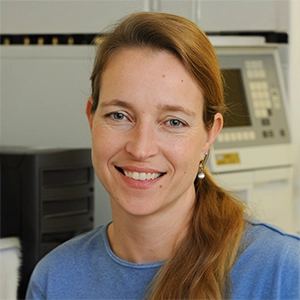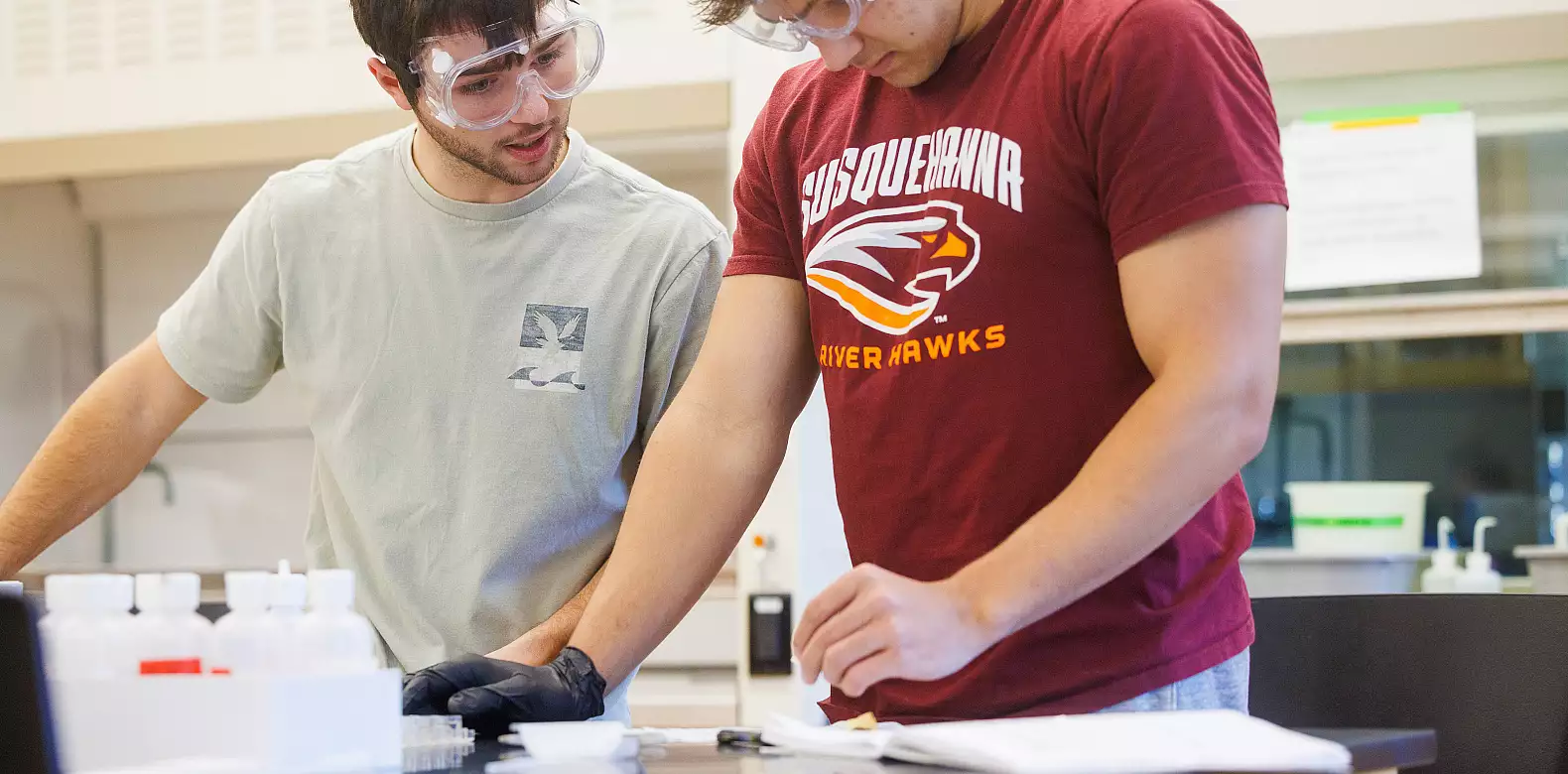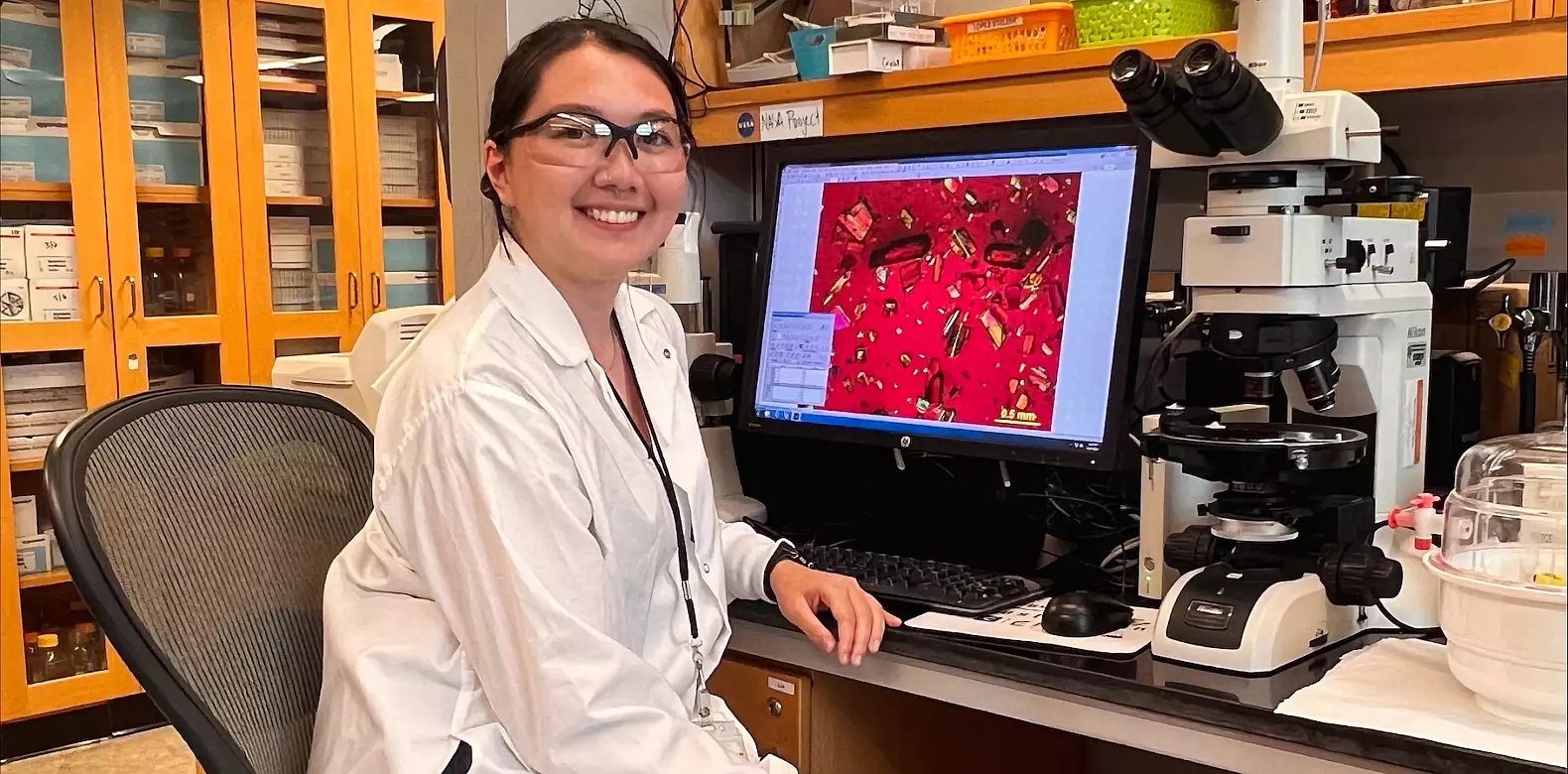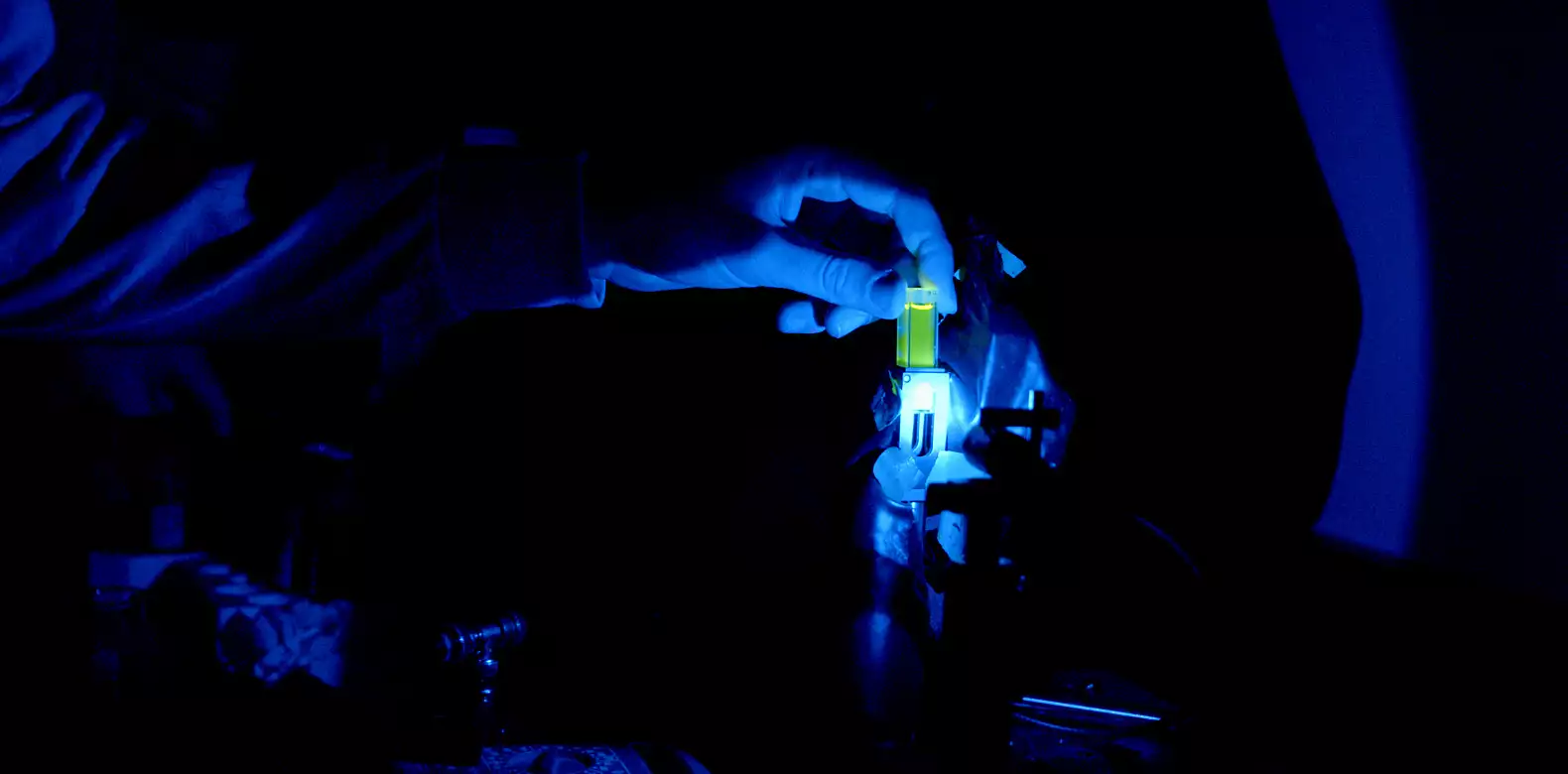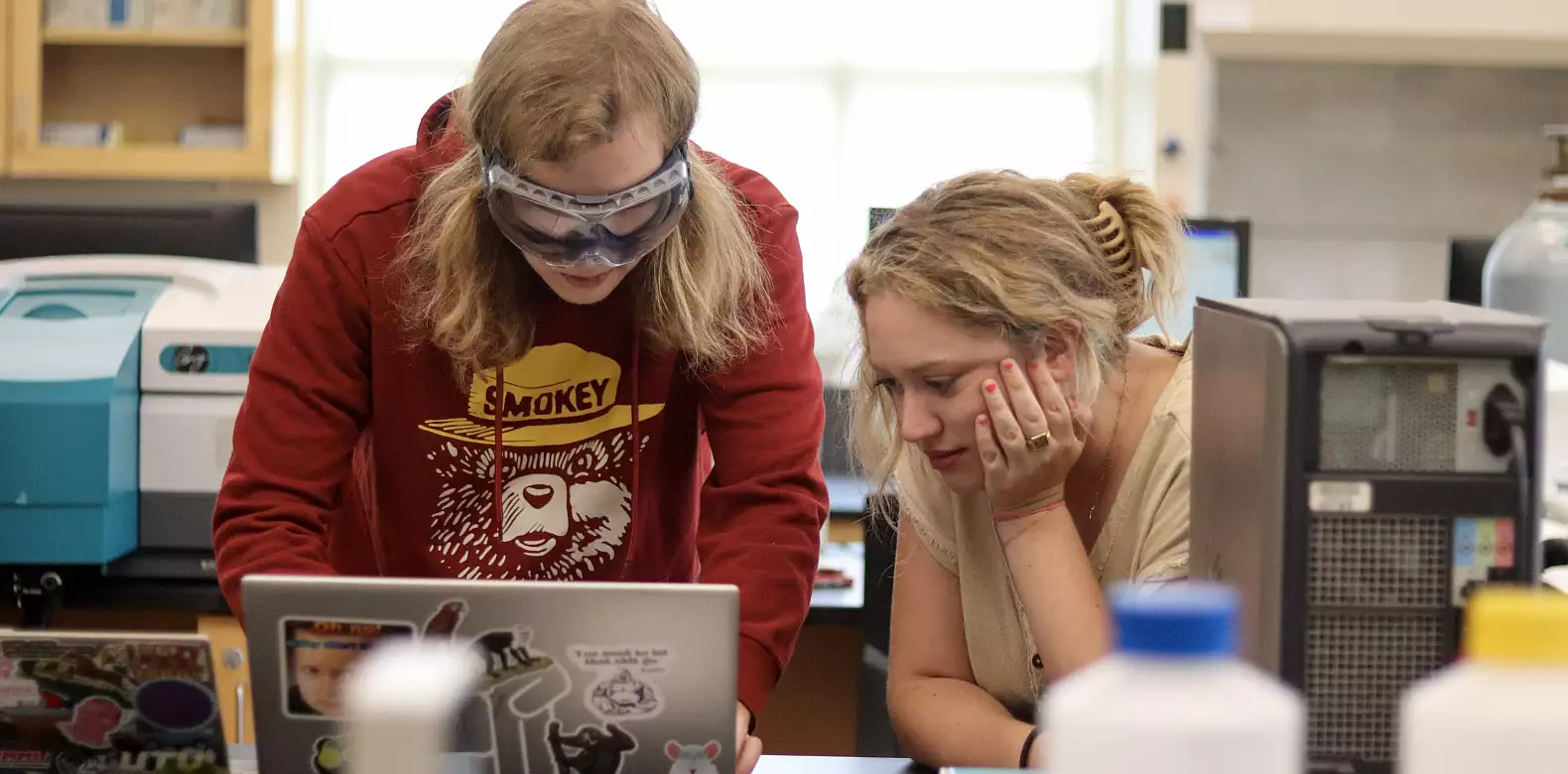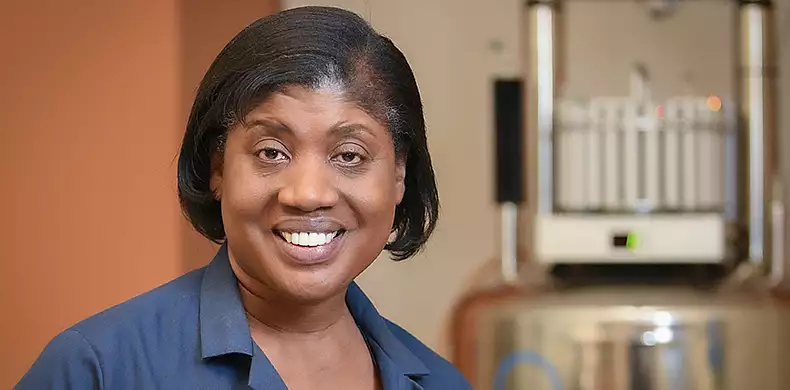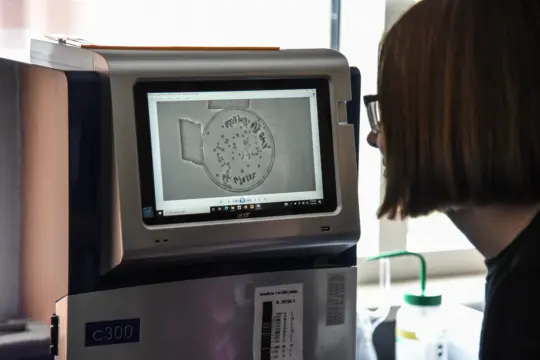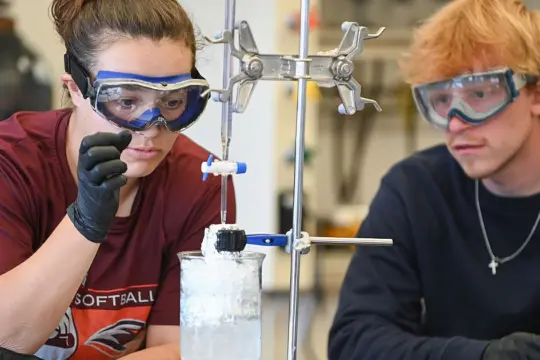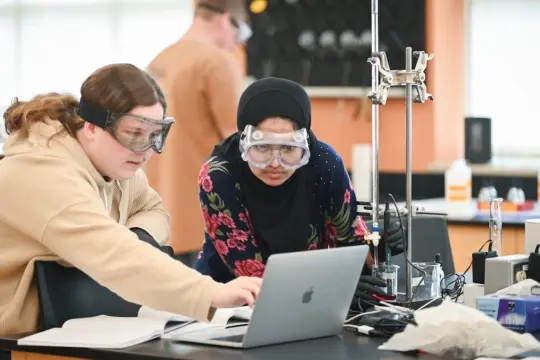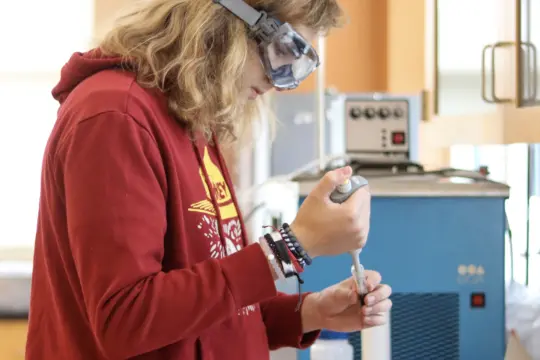Chemistry Degree
Do you want to learn about pharmaceutical sciences or how an MRI scan works? Do you want to help invent the next generation of biodegradable plastics? Do you dream of making solar panels more efficient to help combat climate change? The study of chemistry is the study of curiosity.
Is there a future cancer treatment to be extracted from plants? How can we design the next novel materials for coatings, dyes and therapeutics? What goes into the analysis of crime scene evidence? And what in the world is Nano-Tech? The wide world of chemicals is as diverse as the elements on the periodic table and is applicable in several fields including:
- Medicine
- Materials science
- Forensic science
- Food science
- Manufacturing
- Sustainability
- Education
Susquehanna’s program, accredited by the American Chemical Society, gives you access to accomplished faculty, a coherent curriculum focused on hands-on, problem-based learning and a modern, well-maintained infrastructure. Get hands-on experience with lasers, fluorescence and NMR (nuclear magnetic resonance) spectrometers — over $1 million in equipment.
Your time at Susquehanna will be spent working in cutting-edge labs. You can participate in original research projects as early as your first year and you can use your education as a springboard for graduate programs, medical school or other pre-professional programs, a job as a teacher or in the industry. As a chemistry major, you will be in demand for lucrative careers.
At Susquehanna, you can satisfy your endless curiosity to childhood questions and more. Our faculty will challenge you. Opportunities to conduct research will excite you. And lessons learned from scientific setbacks will only propel you to succeed.
Hands-On Experience from Day one
With a degree in chemistry or biochemistry from Susquehanna, you’ll be prepared for a variety of career pathways.

SUsquehanna By the Numbers
More Than Metrics
100%
of students conduct research with faculty by their junior year
50%
of graduates attend graduate programs, medical school or other pre-professional programs
$1.2m
in recent National Science Foundation funding for scholarships, summer research funding and major instrumentation
75%
of students present their research at the national meeting of the American Chemical Society
Where Passion Meets Purpose
Straight from the Nest


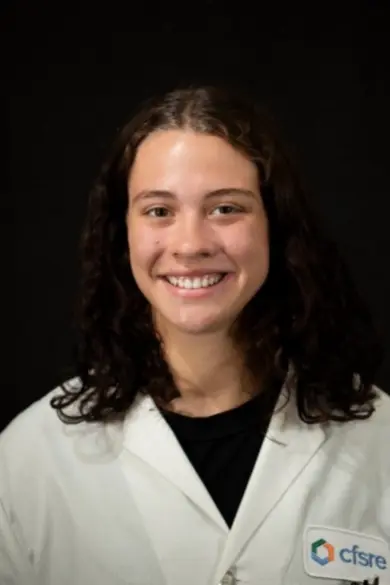
“At a small school like Susquehanna, I’ve had hands-on access to lab instruments both in classes and during independent research with faculty. These experiences have sharpened my techniques and prepared me for a future in chemistry.”
— Chrissy Vo ’25
“I was drawn to the chemistry department at Susquehanna because of the close collaboration between students and professors. The university offers abundant research opportunities, and if you take advantage of them, you will succeed.”
— Olivia Basile ‘24
“I loved the supportive lab environment. Everyone was friendly and eager to help. We learned by using the instruments regularly, which made the material easier to understand. The best way to learn is by doing and that’s exactly what we did.”
— Remi Acord ’25
Action-Oriented LearnIng
Susquehanna Provides a Career Catalyst
The best way to learn is by doing, and that’s exactly what you’ll experience at Susquehanna. Make your chemistry education hands-on with summer research opportunities.
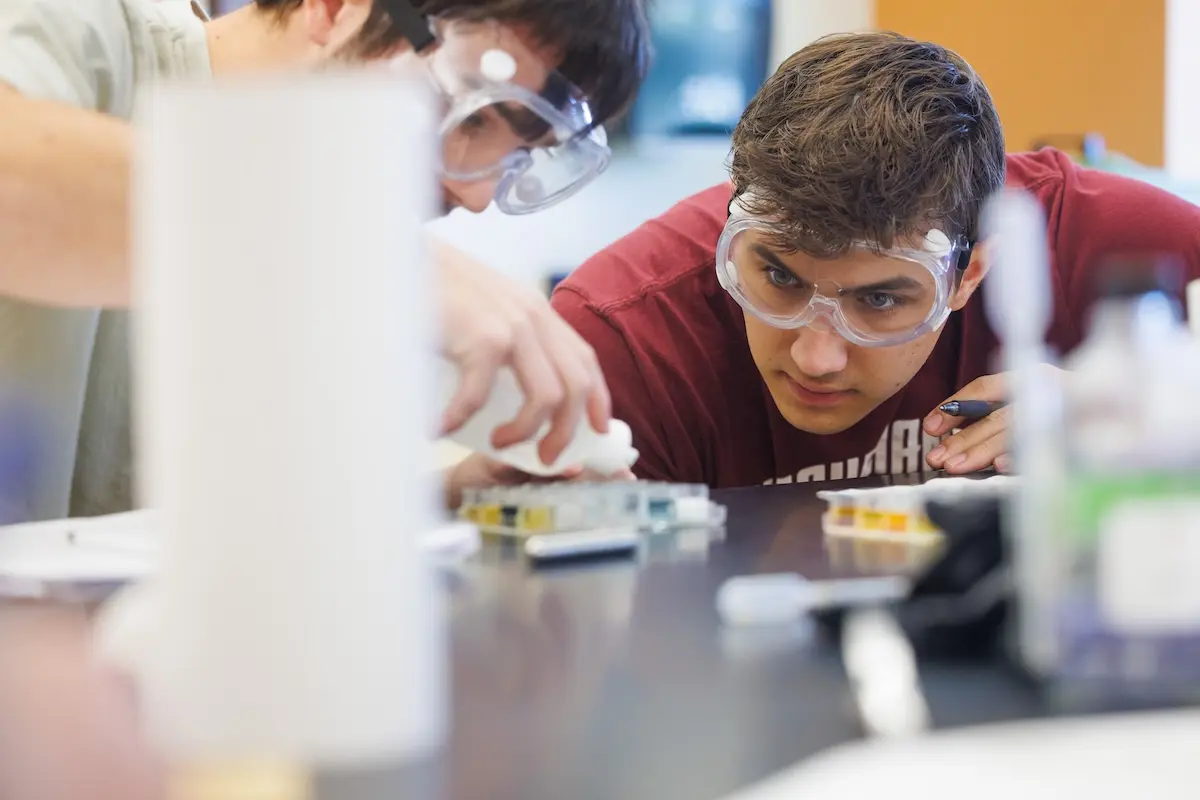
Unlock Prestigious Research Internships
Discover how Susquehanna University’s exceptional internship programs can set you apart, offering hands-on research opportunities and global experiences to prepare you for a successful future in scientific research.
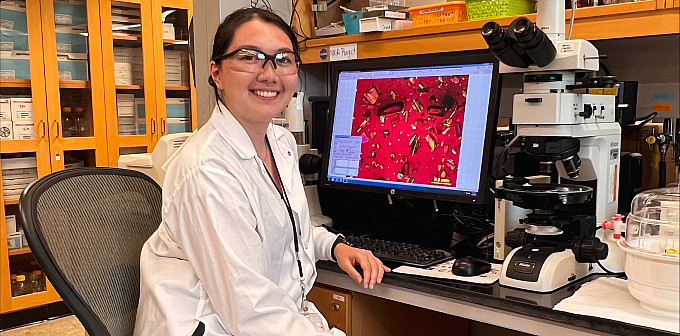
Recent Employers
Beyond Susquehanna
Plan Your Classroom
Program Resources
A Glance Into Your Degree Pathway
With support from advisors and course planning tools, your time at Susquehanna is carefully designed to help you succeed. This example provides a glimpse into your degree experience, but you’ll have plenty of opportunities to customize your path with electives or study abroad programs that reflect your passions and career goals.
Differentiation and integration of polynomials, exponential, logarithmic and trigonometric functions, rules of differentiation, the Mean Value Theorem, L’Hôpital’s Rule, the Fundamental Theorem of Calculus and applications. 4 SH. CC: Analytical Thought.
Basic concepts of stereochemistry and chemistry of aliphatic hydrocarbons, alkyl halides and alcohols. Prerequisite: CHEM-101, CHEM-103 or CHEM-111. 4 SH. 3 lecture hours, 3 laboratory hours (taken as CHEM 221L, not a separate credit/grade).
Techniques of integration. Also includes improper integrals, further applications of integration and power series. Prerequisite: MATH-111 Calculus I or equivalent. 4 SH. CC: Analytical Thought.
This course explores basic concepts of spectroscopy and chemistry of aromatic hydrocarbons, conjugated alkenes, amines, ethers, carbonyl compounds, carboxylic acid derivatives and carbohydrate building blocks. Prerequisite: CHEM-221. 4 SH. 3 lecture hours, 3 laboratory hours (taken as CHEM 222L, not a separate credit/grade). CC: Writing Intensive.
Introduces the macroscopic phenomena of the physical universe. Applies concepts of force, work, energy and momentum to waves, fluids and thermodynamics. Laboratory stresses methods of acquiring data, computer data processing and analyzing the causes of errors. Uses algebra, trigonometry and calculus as the language. Pre- or co-requisite: MATH-111. 4 SH. 3 lecture hours, 3 laboratory hours. CC: Scientific Explanations.
Chemistry
Choose from a variety of elective courses within this program to customize your goals.
Structure and reactivity of solids, liquids, gases and solutions will be investigated. Molecular symmetry, molecular orbital theory and chemical kinetics will be introduced. Basic coordination chemistry will be discussed including molecular and electronic structure, acid/base theory, magnetism and common ligands. Students may receive credit for only one of the three introductory chemistry II courses: CHEM-104 or CHEM-232. Prerequisite: CHEM-222 (Organic Chemistry II). 4 SH. 3 lecture hours, 3 laboratory hours.
Analytical methods for the quantitative determination of chemical species and underlying chemical concepts. Topics include analytical processes, measurements, instrumentation, chemical equilibrium and activity, acid-base theory, voltametric and spectroscopic theory. Laboratories include classical titrations and modern techniques with a focus on potentiometry and analytical optical spectroscopy. Prerequisites: CHEM-103 or CHEM-111. Taken concurrently with CHEM-102, CHEM-104 or CHEM-232 or with instructor permission. 4 SH. 3 lecture hours. 3 laboratory hours.
Continuation of Introductory Physics I. Introduces and applies the concept of a field to gravitation, electricity, magnetism, circuits, optics and the atom. Laboratory stresses electronic data acquisition and independent discovery of physical principles. Uses algebra, trigonometry and calculus as the language. Prerequisite: PHYS-204; pre- or co-requisite: MATH-112. P 4 SH.
An in-depth study of classical and statistical thermodynamics and reaction kinetics presented with applications to phase equilibria, chemical equilibria, solute-solvent interactions and nonequilibrium thermodynamics. Prerequisites: CHEM-242, MATH-112 and PHYS-204 (Calculus-based). 4 SH. 3 lecture hours, 3 laboratory hours. CC: Writing Intensive.
Individual investigation of a novel problem in chemistry or biochemistry in collaboration with a faculty member. May be repeated for credit. Prerequisite: instructor’s permission. 1-4 SH.
This course focuses on the structure of proteins, the thermodynamics of protein folding, enzyme catalytic mechanisms and enzyme kinetics. This course also introduces the field of bioinformatics, the use of computer databases to determine relationships between nucleic acid sequence, protein structure and protein function. Prerequisite: Gen Chem II (CHEM-104) or CHEM-232 Structure and Reactivity; and CHEM-222 Organic Chem II. 3 SH. 3 lecture hours.
Weekly meetings in which students report on current chemical research literature. Researchers from other institutions and industry will also be invited to present their research. Four semester hours in a manner approved by the student’s adviser are required for all majors. Prerequisite: Junior standing. 1-4 SH.
Introduction to quantum chemistry and spectroscopy. Theory of quantum mechanics presented at a fundamental level with special attention paid to classical problems-particle in a box, harmonic oscillator, rigid rotor and hydrogen atom-and practical application to the electronic structure of atoms and molecules and to atomic and molecular spectroscopy. Prerequisites: CHEM-242, MATH-112 and PHYS-206 (Calculus-based) or instructor’s permission. 4 SH. 3 lecture hours, 3 laboratory hours.
Individual investigation of a novel problem in chemistry or biochemistry in collaboration with a faculty member. May be repeated for credit. Prerequisite: instructor’s permission. 1-4 SH.
Weekly meetings in which students report on current chemical research literature. Researchers from other institutions and industry will also be invited to present their research. Four semester hours in a manner approved by the student’s adviser are required for all majors. Prerequisite: Junior standing. 1-4 SH.
Chemistry
Choose from a variety of elective courses within this program to customize your goals.
Individual investigation of a novel problem in chemistry or biochemistry in collaboration with a faculty member. May be repeated for credit. Prerequisite: instructor’s permission. 1-4 SH.
Advanced physical and electronic structure of transitional metal complexes, reaction mechanisms, bulk properties of metals, principles of organometallic chemistry and bioinorganic chemistry. Prerequisite: CHEM-232. 4 SH. 3 lecture hours, 3 laboratory hours.
Weekly meetings in which students report on current chemical research literature. Researchers from other institutions and industry will also be invited to present their research. Four semester hours in a manner approved by the student’s adviser are required for all majors. Prerequisite: Junior standing. 1-4 SH.
Chemistry
Choose from a variety of elective courses within this program to customize your goals.
Instrumental techniques of analysis, focuses on atomic and molecular spectroscopy, including chemical principles behind the instrumental techniques, instrument operation and applications of instrumental analysis. Some discussion of macromolecule (polymer) analysis will also be included. Prerequisite: CHEM-342 or instructor’s permission. 4 SH. 3 lecture hours, 3 laboratory hours.
Individual study of a problem in experimental chemistry under the direction of a faculty member, and public presentation of the results. May not be repeated for credit. Co-/Prerequisite: Senior standing and completion of a minimum of 2 semester hours in CHEM-400 during the junior and/or senior year. 2 SH. Capstone.
Weekly meetings in which students report on current chemical research literature. Researchers from other institutions and industry will also be invited to present their research. Four semester hours in a manner approved by the student’s adviser are required for all majors. Prerequisite: Junior standing. 1-4 SH.
Development of reasoning and quantitative skills for problem solving in chemistry courses. Introduction to atomic structure, chemical reactions, chemical nomenclature, formulas, symbols and equations, dimensional analysis and experimental data analysis methods. 4SH. 4 lecture hours. Not for credit toward chemistry or biochemistry major or minor.
Emphasizes the use of chemistry by society and in nature. This course presents the basic chemical concepts in a variety of contexts. Subjects might include environmentally friendly “green” chemistry, medicinal, nanotechnology, chemistry of movies and magic, or chemistry of everyday objects. A student may not enroll in this course after completing General Chemistry I (CHEM-103 or CHEM-111). Pre-requisite: concurrent enrollment in CHEM-100L. 4 SH. 3 lecture hours, 3 laboratory hours. CC: Scientific Explanations.
Lab which accompanies CHEM-100 Trends in Chemistry, which emphasizes the use of chemistry by society and in nature. This course presents the basic chemical concepts in a variety of contexts. Subjects might include environmentally friendly “green” chemistry, medicinal, nanotechnology, chemistry of movies and magic, or chemistry of everyday objects. Concurrent enrollment in CHEM-100 is required.
Fundamental laws and principles, atomic structure and periodicity, bonding, molecular structure, stoichiometry, chemical reactions, energy, equilibrium, thermodynamics and nuclear chemistry. Students may receive credit for only one of the three introductory Chemistry I courses, CHEM-103 or CHEM-111. 4 SH. 3 lecture hours, 3 laboratory hours (taken as CHEM-105, not a separate credit/grade). CC: Scientific Explanations.
Properties of gases, liquids, solids and solutions, kinetics, acids, bases, buffers, solubility, complex ion equilibria, electrochemistry, and descriptive and coordination chemistry taught in a team-based format. Students may receive credit for only one of the three introductory chemistry II courses: CHEM-102, CHEM-104 or CHEM-232. Prerequisite: CHEM-103 or CHEM-111. 4 SH. 3 lecture hours, 3 laboratory hours (taken as CHEM-106, not a separate credit/grade).
Fundamental laws and principles, atomic structure and periodicity, bonding, molecular structure, stoichiometry, chemical reactions, energy, simple acid-base equilibria, thermodynamics and kinetics taught in a team-based workshop format, with the lab and lecture integrated. Students may receive credit for only one of the two introductory chemistry I courses, CHEM-103 or CHEM-111. 4 SH. 3 lecture hours, 3 laboratory hours. CC: Scientific Explanations.
Individual or team investigation of a novel problem in chemistry or biochemistry in collaboration with a faculty member. Introduction to common methods and techniques used in the chemistry and biochemistry fields. This course may only be taken in the first and/or second year of the Chemistry/Biochemistry/Chemical Physics program and can be repeated for credit. Prerequisite: Instructor’s permission. 1-4 SH.
Basic concepts of stereochemistry and chemistry of aliphatic hydrocarbons, alkyl halides and alcohols. Prerequisite: CHEM-101, CHEM-103 or CHEM-111. 4 SH. 3 lecture hours, 3 laboratory hours (taken as CHEM 221L, not a separate credit/grade).
This course explores basic concepts of spectroscopy and chemistry of aromatic hydrocarbons, conjugated alkenes, amines, ethers, carbonyl compounds, carboxylic acid derivatives and carbohydrate building blocks. Prerequisite: CHEM-221. 4 SH. 3 lecture hours, 3 laboratory hours (taken as CHEM 222L, not a separate credit/grade). CC: Writing Intensive.
Structure and reactivity of solids, liquids, gases and solutions will be investigated. Molecular symmetry, molecular orbital theory and chemical kinetics will be introduced. Basic coordination chemistry will be discussed including molecular and electronic structure, acid/base theory, magnetism and common ligands. Students may receive credit for only one of the three introductory chemistry II courses: CHEM-104 or CHEM-232. Prerequisite: CHEM-222 (Organic Chemistry II). 4 SH. 3 lecture hours, 3 laboratory hours.
Analytical methods for the quantitative determination of chemical species and underlying chemical concepts. Topics include analytical processes, measurements, instrumentation, chemical equilibrium and activity, acid-base theory, voltametric and spectroscopic theory. Laboratories include classical titrations and modern techniques with a focus on potentiometry and analytical optical spectroscopy. Prerequisites: CHEM-103 or CHEM-111. Taken concurrently with CHEM-102, CHEM-104 or CHEM-232 or with instructor permission. 4 SH. 3 lecture hours. 3 laboratory hours.
Varied topics reflecting student and instructor interests. Possibilities include organometallic chemistry, environmental chemistry, green chemistry, proteomics and chemistry of art. Prerequisite: CHEM-222 (may be others for some topics). 1-4 SH. Offered as lecture only, laboratory only or as a lecture/laboratory combination.
This course integrates principles from the disciplines of chemistry, biology and pharmacology to study the discovery, design, and mechanisms of action of important anticancer, antiviral, antibacterial, cardioprotective and antidepressant drugs. Major emphasis is placed on drug interactions with nucleic acids, enzymes and receptors. Offered as lecture only. Prerequisites: Junior standing and CHEM-222. CC: Interdisciplinary.
Examines the science and the scientific method through the lens of ethics to distinguish scientific error from outright fraud. The course looks at classic and contemporary scientific blunders and fraud cases in academia, industry, and government. Examines ethical policy from the fallout of academic fraud. Prerequisite: Sophomore standing and CHEM:222. 4 SH. CC: Ethics Intensive, Interdisciplinary.
In this course, students will learn about partition coefficient and biopharmacy, physicochemical properties of drugs, stereochemistry, drug metabolism, volumetric analysis of drugs, analytical spectroscopy, stability of drugs and medicines, kinetics of drug stability, licensing of drugs and the British Pharmacopoeia, method validation, and GMPs. Prerequisite: Junior standing and CHEM-222. 4 SH. 4 lecture hours (may be taught 3 lecture hours, 3 laboratory hours). CC: Interdisciplinary.
This course approaches the challenges, methods, analyses and ethics of forensic chemistry from fundamental chemical and biological perspectives, including quality assurance, sampling and evidence collection and preservation, instrumentation, drugs as physical evidence, analysis of seized drugs, drugs in the body, forensic toxicology, combustion and arson, explosives, firearms, colorants, polymers, paper and fibers and forensic DNA analysis. Students will also be able to articulate the basic ethical questions and issues related to the study of forensics. Prerequisites: Junior standing and CHEM-222. 4 SH. 4 lecture hours (may be taught 3 lecture hours, 3 laboratory hours). CC: Ethics Intensive, Interdisciplinary.
An introduction to many aspects of nanoscience and nanotechnology. Interdisciplinary connections between chemistry, physics, biology and material science are investigated through readings, discussions and laboratory experiments. Major topics include the formation and implementation of nano-structured systems, synthesis and detection of nanoparticles, their current roles in technology, medical applications, ethical implications, and the likely future impact of such systems on society, industry and the environment. Prerequisites: Sophomore standing and CHEM-222. 4 SH. CC: Interdisciplinary.
Chemical species are analyzed by classical quantitative and modern spectrometric methods. Laboratories range from volumetric, gravimetric and potentiometric wet techniques to photospectrometric methods (Uv-vis, FT-IR, AA) and mass spectrometry. This class is specifically designed for the chemistry minor and does not count toward the chemistry major, the biochemistry major or as an elective. Prerequisites: CHEM-102, or CHEM-103-104 or CHEM- 111-112. 4 SH. 3 lecture hours, 3 laboratory hours.
Biotechnology is broadly defined as the application of the principles of molecular and cellular science to the production of biologically important or industrially useful products. Understanding how DNA-templated process are regulated is key to understanding many aspects of biology: cell development and differentiation, the impact of the environment on cellular process, the development, progression and treatment of diseases, etc. This course will explore how scientists use this information to create breakthroughs in disease treatment, the development of genetically modified crops, the development of cutting-edge vaccines, etc. This course will begin with a review of general principles of chemistry, biochemistry, biology and molecular biology. In addition, this course will explore the “tools of the trade” that are used by omics scientists. The course will conclude with a study and discussion of the moral and ethical implications of this information. It will look at rules and regulations governing this information and how the information may be used for the study of diseases (diagnostics, treatments, etc.). It is strongly recommended that students take BIOL-426/CHEM-426 prior to this course. Prerequisite: CHEM 222: Organic Chemistry II. 4 SH
A survey of Biochemistry: structure and function of amino acids, proteins, lipids, carbohydrates and nucleic acids; enzymology; metabolism; biosynthesis; and selected topics. Not acceptable for credit toward a major in chemistry or biochemistry, nor biochemistry minor. Prerequisites: CHEM-104 General Chemistry II or CHEM-232 Structure and Reactivity; and CHEM-222 Organic Chemistry II. 4 SH.
An in-depth study of classical and statistical thermodynamics and reaction kinetics presented with applications to phase equilibria, chemical equilibria, solute-solvent interactions and nonequilibrium thermodynamics. Prerequisites: CHEM-242, MATH-112 and PHYS-204 (Calculus-based). 4 SH. 3 lecture hours, 3 laboratory hours. CC: Writing Intensive.
Introduction to quantum chemistry and spectroscopy. Theory of quantum mechanics presented at a fundamental level with special attention paid to classical problems-particle in a box, harmonic oscillator, rigid rotor and hydrogen atom-and practical application to the electronic structure of atoms and molecules and to atomic and molecular spectroscopy. Prerequisites: CHEM-242, MATH-112 and PHYS-206 (Calculus-based) or instructor’s permission. 4 SH. 3 lecture hours, 3 laboratory hours.
Individual investigation of a novel problem in chemistry or biochemistry in collaboration with a faculty member. May be repeated for credit. Prerequisite: instructor’s permission. 1-4 SH.
This course integrates information from the disciplines of biology and chemistry to explore nucleic acid function and metabolism. In-depth discussions cover the forces behind DNA/DNA, DNA/RNA and DNA/protein interactions as they apply to DNA structure and metabolism, RNA function and metabolism, protein synthesis, and gene regulation. Prerequisite: CHEM-104 General Chemistry II or CHEM-232 Structure and Reactivity; and CHEM-222 Organic Chemistry II. Strongly recommended: BIOL-426/CHEM-426. 3 SH. 3 lecture hours.
Exploration of nucleic acids, including methods of isolation, purification, identification and analysis. Prerequisite: Gen Chem II (CHEM-104) or CHEM-232 Structure and Reactivity; and CHEM-222 Organic Chem II. 1 SH. 3 laboratory hours.
This course covers the structure and function of major biomolecules such as carbohydrates and lipids and their role in metabolism. Energy metabolism and biomolecule biosynthesis and degradation are emphasized. Prerequisite: Gen Chem II (CHEM-104) or CHEM-232 Structure and Reactivity; and CHEM-222 Organic Chem II. Strongly recommended: BIOL-426/CHEM-426. 3 SH. 3 lecture hours.
This course focuses on the structure of proteins, the thermodynamics of protein folding, enzyme catalytic mechanisms and enzyme kinetics. This course also introduces the field of bioinformatics, the use of computer databases to determine relationships between nucleic acid sequence, protein structure and protein function. Prerequisite: Gen Chem II (CHEM-104) or CHEM-232 Structure and Reactivity; and CHEM-222 Organic Chem II. 3 SH. 3 lecture hours.
This lab explores enzyme kinetics and inhibition as well as methods of isolation, purification, identification and analysis of proteins and enzymes. This lab is designed to provide technical skills necessary for biochemical research. Prerequisite: Gen Chem II (CHEM-104) or CHEM-232 Structure and Reactivity; and CHEM-222 Organic Chem II. 1 SH. 3 laboratory hours.
This lab explores metabolic function and metabolites. The lab focuses on the isolation, purification, identification and analysis of metabolites. Prerequisite: Gen Chem II (CHEM-104) or CHEM-232 Structure and Reactivity; and CHEM-222 Organic Chem II. 1 SH. 3 laboratory hours.
Instrumental techniques of analysis, focuses on atomic and molecular spectroscopy, including chemical principles behind the instrumental techniques, instrument operation and applications of instrumental analysis. Some discussion of macromolecule (polymer) analysis will also be included. Prerequisite: CHEM-342 or instructor’s permission. 4 SH. 3 lecture hours, 3 laboratory hours.
Advanced physical and electronic structure of transitional metal complexes, reaction mechanisms, bulk properties of metals, principles of organometallic chemistry and bioinorganic chemistry. Prerequisite: CHEM-232. 4 SH. 3 lecture hours, 3 laboratory hours.
Individual work for qualified students under the direction of a faculty member. Usually deals with specialized topics not covered in regularly offered courses. Prerequisite: Instructor and department head approval. 2-4 SH.
Individual study of a problem in experimental chemistry under the direction of a faculty member, and public presentation of the results. May not be repeated for credit. Co-/Prerequisite: Senior standing and completion of a minimum of 2 semester hours in CHEM-400 during the junior and/or senior year. 2 SH. Capstone.
Investigation of a specific topic or problem under the guidance of an appropriate faculty member. 1-4 SH.
Weekly meetings in which students report on current chemical research literature. Researchers from other institutions and industry will also be invited to present their research. Four semester hours in a manner approved by the student’s adviser are required for all majors. Prerequisite: Junior standing. 1-4 SH.
Selected students work in the chemical industry under the supervision of an industrial chemist. Prerequisite: CHEM-242 and department head’s permission. 4 SH. S/U grade.
When you enroll at Susquehanna, you’ll be paired with an advisor and application tool to guide you in your course planning and scheduling. The following is an excerpt from the complete course catalog. Enrolled students follow the requirements of the course catalog for the academic year in which they declare each major and/or minor, consult with their advisor(s).
Learning Goals
- Demonstrate the ability to apply appropriate chemical and physical models to make predictions or draw conclusions regarding chemical systems or phenomenon. Examples of chemical systems are compound formation (synthesis), energy transfer, equilibrium composition, various physical properties, chemical reactivity, etc.
- Demonstrate mastery of laboratory skills and execute common experimental techniques.
- Demonstrate the ability to design, prepare, execute and adjust experiments.
- Describe the theoretical and operational principles of common laboratory instrumentation such as NMR, FT- IR, UV-Vis, AA, fluorescence spectrometers, GC-MS, HPLC and electrochemical analysis instrumentation, as well as their typical uses, sensitivities and limitations. Interpret the data collected with such instrumentation.
- Find topic-specific chemical literature, interpret and evaluate chemical studies as described in scientific journals, and describe these conclusions through written and oral presentations.
- Analyze and interpret data to detect trends, evaluate the quality of data and reach scientifically valid conclusions.
American Chemical Society Accreditation
The department’s major in chemistry is accredited by the American Chemical Society.
Majors in Chemistry, Biochemistry and Chemical Physics
Susquehanna offers a Bachelor of Arts degree in chemistry and Bachelor of Science degrees in chemistry, biochemistry and chemical physics. Two biochemistry tracks are available: an ACS-Certified track and a Biology-Intensive track. The ACS-Certified track includes courses that cover properties of metals, spectroscopic techniques and instrumental methods that will prepare students for careers or graduate programs in the areas of biochemistry or biophysics. The Biology-Intensive track includes courses that will offer a solid foundation in chemical principles in addition to biological systems and will prepare students for careers or graduate programs in the biological sciences or biochemistry, or the health care professions. All required courses must be completed with a grade of C- or higher.
Double-counting restriction
Students may only pursue either a single major or minor offered by the Department of Chemistry.
Chemistry
The Bachelor of Arts degree in chemistry requires the following courses, with grades of C- or better:
- 4 General Chemistry I – choose from: CHEM-103 or CHEM-111
- 4 General Chemistry II – choose from: CHEM-104 or CHEM-232
- 4 CHEM-221 Organic Chemistry I
- 4 CHEM-222 Organic Chemistry II
- 4 CHEM-242 Methods of Chemical Analysis
- 4 CHEM-341 Physical Chemistry I
- 4 CHEM-342 Physical Chemistry II
- 4 CHEM-450 Advanced Inorganic Chemistry
- 4 PHYS-204 Introductory Physics I (Calculus-based)
- 4 PHYS-206 Introductory Physics II (Calculus-based)
- 4 Four semester equivalents of CHEM-505 Seminar
- 0-8 Mathematics through MATH-112 Calculus II
- 2 CHEM-400 Research Experience
- 2 CHEM-500 Problems in Chemistry and Biochemistry
Other chemistry courses selected to fulfill career goals.
The Bachelor of Science degree in chemistry with American Chemical Society certification
The Bachelor of Science degree in chemistry with American Chemical Society certification requires a minimum of 49 semester hours in chemistry. Students will meet the requirements for the degree by completing the following courses:
- All courses required for the Bachelor of Arts degree
- CHEM-430 Instrumental Analysis
- One biochemistry course from among:
- CHEM-422 The Biochemistry of Nucleic Acids
- CHEM-424 The Biochemistry of Metabolism
- CHEM-426 The Biochemistry of Proteins and Enzymes
- One elective course from among:
- CHEM-300 Topics in Chemistry
- CHEM-302 Medicinal Chemistry
- CHEM-303 Scientific Ethics, Blunders, and Fraud
- CHEM-304 Pharmaceutical Chemistry
- CHEM-305 Forensic Chemistry
- CHEM-306 Nanoscience
In addition, students will complete a minimum of four semester hours of CHEM-400 during the junior and/or senior year (including the two semester hours required for the Bachelor of Arts degree) and either MATH-201 Linear Algebra or MATH-353 Differential Equations.
A student completing a double major that includes a Bachelor of Arts or Bachelor of Science degree in Chemistry may replace CHEM-500 with a capstone in the second major.
Secondary Teaching Certification
The Chemistry Department offers secondary teaching certification for both chemistry and biochemistry majors.
Secondary Teaching Certification Coursework required by the state of Pennsylvania for admission to the teacher certification program includes successful completion of FYSE-100 or equivalent course (having learning goals related to English composition), at least 3 semester hours in British or American literature, at least 6 semester hours of mathematics coursework (or other courses which satisfy the Central Curriculum Analytical Thought requirement) and at least one 40-hour externship.
Education requirements for secondary education are:
- EDUC-500 Student Teaching package (EDUC-501, EDUC-502, EDUC-503, and EDUC-600)
- EDUC-101 Introduction to Education and Society
- EDUC-250 Educational Psychology
- EDUC-260 Introduction to Special Education
- EDUC-270 Instruction of Exceptional Students
- EDUC-330 Technology in Education
- EDUC- 350 English Language Learners: Theory and Instruction
- EDUC-380 Instructional Design
- EDUC-424 Methods of Curriculum, Instruction, and Assessment in Teaching Science
- EDUC-479 Principles of Learning and Teaching in Secondary Education
- EDUC-483 Differentiated Instruction and Classroom Management in Secondary Education
In addition, secondary education chemistry students complete all of the usual requirements for the chemistry or biochemistry major, except for CHEM-400, and CHEM-500 (which is fulfilled with EDUC-500 Student Teaching Package.) While not required, it is recommended that secondary education students complete at least 2 semester hours of CHEM-400.
Honors in Chemistry
The departmental honors program encourages and recognizes superior performance in chemistry. To graduate with honors in chemistry, candidates must do the following:
- Maintain at least a 3.25 cumulative GPA overall and a 3.50 cumulative GPA in chemistry courses (plus biology courses for biochemistry majors)
- Petition the research advisor in writing by the third week of their final semester. The research advisor will make a request on behalf of the honors candidate to the department chair.
- Upon departmental approval, submit an acceptable written thesis based on a minimum of 4 semester hours of CHEM-400, completed during the junior and/or senior years, and CHEM-500 (or BIOL-510 and BIOL-511, if approved by Chemistry Department)
- Pass an oral thesis defense
When you enroll at Susquehanna, you’ll be paired with an advisor and application tool to guide you in your course planning and scheduling. The following is an excerpt from the complete course catalog. Enrolled students follow the requirements of the course catalog for the academic year in which they declare each major and/or minor and consult with their advisor(s).
Minor in Chemistry
Students minoring in chemistry complete five courses:
- General Chemistry I (CHEM- 103 or CHEM-111)
- General Chemistry II (CHEM-104) or Structure and Reactivity (CHEM-232)
- Organic Chemistry I (CHEM-221)
- Organic Chemistry II (CHEM-222) or Physical Chemistry I (CHEM-341)
- One of the following courses:
- Analytic Chemistry (CHEM-311)
- Topics in Chemistry (CHEM-300)
- Medicinal Chemistry (CHEM-302)
- Scientific Ethics, Blunders, and Fraud (CHEM-303)
- Pharmaceutical Chemistry (CHEM-304)
- Forensic Chemistry (CHEM-305)
- Nanoscience (CHEM-306)
Methods of Chemical Analysis (CHEM-242) may be used to fulfill the minor requirement, but is only recommended if a student completes Structure and Reactivity instead of General Chem II.
- General medical practitioner or specialist
- Dentist or orthodontist
- Pharmacologist
- Nurse
- Industrial chemist
- Chemical engineer
- Research chemist
- Food scientist
- College or high school teacher
TAKE A VIRTUAL TOUR
Launch Natural Sciences CenterMeet the Faculty
YOU MAY ALSO BE INTERESTED IN
See the full list of related programs on the School of Natural & Social Sciences page.
Have Questions?
Contact Us
Start your journey.







